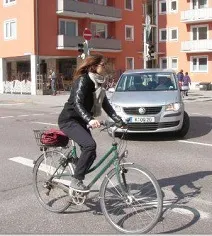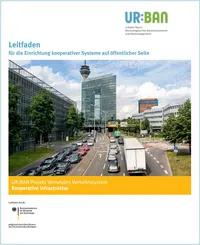Project Description
The research project UR:BAN was initiated to contend with transportation challenges presented by increasing urbanization in metropolitan regions. The aims of the initiative are to increase traffic safety in urban areas as well as to facilitate economical, energy efficient and low emission transportation. 32 project partners from the automotive and automotive supply industries, companies specializing in electronics, communications, software development, and insurance, as well as research institutions and city governments have come together to develop driver assistance and traffic management systems for urban areas. Human beings, and their many rolls in transportation systems, will play a central role in the research done within this initiative. UR:BAN is divided into three project pillars.
The Chair of Traffic Engineering and Control at the Technische Universität München takes part in two of the project pillars: Vernetztes Verkehrssystem VV (Networked Transportation System) and Mensch im Verkehr MV (Human Beings in Traffic).
Vernetztes Verkehrssystem VV (Networked Transportation System)

The central component of the project pillar Vernetztes Verkehrssystem (Networked Transportation System) is the development of applications for energy efficient and economical transport in the urban environment. This project pillar is composed of four sub-projects: Regionales Netz RN (Regional Network), Urbane Straße US (Urban Street), Smarte Kreuzung SK (Smart Intersections) and Kooperative Infrastruktur KI (Cooperative Infrastructure). The Chair of Traffic Engineering and Control works actively in the sub-projects US (Urban Street) and KI (Cooperative Infrastructure). The outcomes from the three sub-projects RN, US and SK are taken as an input for KI, in which an analysis of the technical and traffic impacts will be carried out.
- Regionales Netz RN (Regional Network): Expansion of traffic management systems to include environmental aspects and to consider different vehicle propulsion concepts (e.g. diesel, hybrid and electric powered vehicles) both in the development of urban policies and the route selection of vehicles.
- Urbane Straße US (Urban Street): Basic components for the provision of comprehensive data and information from the infrastructure to the vehicle are developed. The focus is on providing forecasts for the traffic light changing times for traffic lights that are located in urban environments.
- Smarte Kreuzung SK (Smart Intersections): The focus of this sub-project is to develop innovative vehicle and traffic control technologies that will facilitate efficient and environmentally traffic at urban intersections. The cooperative exchange of information at local traffic signals by vehicles, public transportation and emergency vehicles as well as by bicyclists and pedestrians to support a traffic and energy optimized transport system is the main focus of this sub-project.
- Kooperative Infrastruktur (KI) (Cooperative Infrastructure): This sub-project ensures the transferability and the development of reference systems on the part of the public authorities. In KI, the sustainability of the research project is guaranteed and the applicability of the UR:BAN results for the introduction of cooperative systems in the community is ensured.
- Within the sub-project KI the Chair of Traffic Engineering and Control is leading the creation of guidelines to implement cooperative systems for the public sector.

Within this project pillar the behaviour of road users in an increasingly networked transportation environment is studied. The resulting knowledge is used to ensure that the diverse needs of road users are met and that drivers are not overburdened with warning information in complex situations. The project pillar is divided into five sub-projects: Urbanes Fahren UF (Urban Driving), Mensch-Maschine-Interaktion MMI (Human-Machine-Interface), Verhaltensprädikation/ Intentionserkennung VIE (Behaviour Prediction / Intention Recognition), Simulation SIM und Kontrollierbarkeit KON (Controllability). The Chair of Traffic Engineering and Control is active in the sub-project UF and takes a leading role in the sub-project SIM.
- Urbanes Fahren (UF): This sub-project acts as a common platform between the sub-projects within MV and the UR:BAN project pillars KA and VV. The purpose of UF is to standardize and specify the assistance scenarios as well as internal project data standards.
-
Simulation SIM: The objective of this sub-project is to analyze and develop descriptive models of the behaviour and interaction of road users in coordination with the applications developed in the UR:BAN project pillars KA and VV. The focus of SIM is the behaviour of informed and assisted drivers with consideration of their interactions with other vehicles (with and without UR:BAN technologies), motorcyclists, bicyclists and pedestrians.
- Within the SIM project, the Chair of Traffic Engineering and Control developed a bicycle simulator.
Kognitive Assistenz KA (Cognitive Assistance)
In this project pillar, assistance systems for the urban environment are developed. Four key aspects will be considered in the following sub-projects: Umgebungserfassung und Umfeldmodellierung UEM (Surrounding Detection and Environmental Modelling), Schutz von schwächeren Verkehrsteilnehmern SVT (Protection of Vulnerable Road Users), Kollisionsvermeidung durch Ausweichen und Bremsen KAB (Collisions Prevention by Evasion and Braking) and Sichere Quer- und Längsführung in der Stadt SQL (Safe Lateral and Longitudinal Guidance in the City).
Tasks of the Chair
- Data collection, analysis and modeling of the movement of bicyclists as well as the interaction between vehicle drivers, bicyclists and other vulnerable road users.
- Centralized optimization of traffic signal control with consideration of heavy duty vehicle (truck) platoons. The research is carried out within the framework of green wave optimization.
- Assessment of the effectiveness of the developed systems/applications concerning traffic efficiency and environmental impact. Calculation is based on a given location (Dusseldorf) and is calculated using a simulation based extrapolation.
- System architecture for cooperative systems in urban environements with consideration of ITS framework architechture and data format.
| Keywords | Urban Environment, Behaviour Modeling, Traffic Signal Control, Measure Assessment and Evaluation, Microsimulation |
| Funding | Bundesministerium für Wirtschaft und Technologie (BMWi) |
| Project Partners | Adam Opel AG, AUDI AG, AZT Automotive GmbH, BMW AG, BMW Forschung & Technik GmbH, Bundesanstalt für Staßenwesen, Continental Automotive GmbH, Continental Safety Engineering Internat. GmbH, Continental Teves AG &Cos. oHG, Daimler AG, Deutsches Zentrum für Luft- und Raumfahrt e.V., Fraunhofer IAO, GEVAS Software GmbH, Hochschule für Technik und Wirtschaft des Saarlandes, ifak Magdeburg e.V., Landeshauptstadt Düsseldorf, MAN Truck & Bus AG, PTV AG, Robert Bosch GmbH, RWTH Aachen, Stadt Kassel, Technische Universität Braunschweig,Technische Universität Chemnitz, Technische Universität München, TomTom Mobility Solutions GmbH, TRANSVER GmbH, Universität der Bundeswehr München, Universität Duisburg-Essen, Universität Kassel, Universität Würzburg, Volkswagen AG |
| Project Duration | January 2012 till December 2015 |
| Contact | Dr. Silja Hoffmann, Jakob Kaths, Judith Gessenhardt, Heather Twaddle, Eftychios Papapanagiotou |
| Further Information | Project Information Sheet (pdf), Project Homepage |


